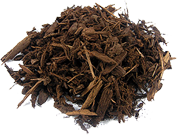
Deciding Which Mulch to Use?
Mulch is a protective covering of various substances...placed on the earth around plants to retard weed growth, prevent moisture evaporation, and moderate fluctuations in soil temperature.
Organic vs. Inorganic Materials:
One basic decision is whether to use inorganic materials (mostly stones and gravel) or organic materials (mostly products like bark, chipped or shredded wood, or nut shells). Here are some pros and cons:
• Stones and Gravel are relatively permanent, with little need to supplement them over time. They resist wind and water erosion better than most organic materials and are available in a variety of colors and textures. They drain quickly and
are effective in collecting condensation and retaining soil moisture. But, they reflect heat and light and they are hard to move if you change your mind. Gaps between large stones can be hard to keep free of leaf and other litter without using
a blower, and weeds may lodge in dirt that blows in between stones. However, small, tightly packed stones will usually remain windswept and fairly clear of leaf litter.
• Bark and Chipped or Shredded Wood Materials decompose over time, providing a good environment for the
cultivation of soil microorganisms and adding nutrients – especially trace elements – to soil, thereby aiding plant development (although it is sometimes recommended that nitrogen be added to the soil to offset the depletion associated with organic decomposition). If applied to an appropriate depth, organic mulches are effective in retaining moisture, while blocking many weeds. Many organic mulches are made from renewable resources and/or recycled waste products. The initial cost is usually less than for inorganic mulches and they are available in a variety of textures. Additionally, they can
be moved easily to make way for changes and most leaf litter can be left in place to simply blend into the mulch. But, organic mulches need regular renewal because of decomposition and shrinkage. Since they are relatively light, they can be displaced by wind and water erosion. Additionally, organic mulches often absorb water and may be inappropriate for use around plants that are susceptible to fungal diseases or rot. Conversely, because they are potentially combustible when
dry, organic mulches may not be appropriate for use in areas prone to wildfires.
Considerations:
Different types of mulch can be used in different areas of your garden. In selecting materials for each area, here are some questions to ask yourself:
• What sort of appearance are you trying to achieve? Gravel and rock materials are appropriate for desert or alpine inspired landscapes, while wood products are probably more at home in “oasis” areas.
• What sort of plants do you plan to install, or what flora is already on the site? You may have to do some research into the plants’ preferred growing conditions. Some xeric plants (gaillardia, cacti, etc.) really prefer to be planted in mineral soils with inorganic mulches, whereas other plants will suffer from sun scald if planted in gravel zones where
light reflection is a problem.
• Is the area shaded, or is it sunny? Glare and heat reflection can be problematic in sunny areas, especially near
windows. Generally darker materials are helpful in reducing glare, but almost any kind of stone or gravel will reflect heat.
• Is the area flat or does it slope? Is the area windy or is it sheltered? Steep slopes and windy areas generally require
heavier materials or materials that will knit together to resist wind and water erosion.
• What kinds of activities or traffic can you expect or wish to discourage in the area to be mulched? For heavily trafficked areas, you may want to provide pathways of compacted crusher fines or “walk on”, finely textured, bark or wood chips. Coarser materials like stones or large bark chunks that make for difficult footing would be good selections
for areas where you want to discourage traffic.
• Finally, what is your budget? Be sure to consider initial cost as well as future maintenance requirements.
Hints:
• Use more attractive, expensive materials near your house and less expensive materials, e.g., aged chipper debris, in outlying areas.
• Make sure all materials are disease and insect free. Green organic material can be used in walkways, but is not
recommended in plant areas.
• Use a variety of mulch materials to create or enhance different microclimates in the garden: stone mulch that radiates
heat can help protect heat loving plants in the winter, while organic mulches can be used to keep soil cool in the spring
to extend the winter dormancy of plants that might be damaged by late frosts.
• Install mulch to the recommended depth to ensure good performance. Typically, coarser textured mulches are installed
to a thicker depth than more finely textured mulches.
